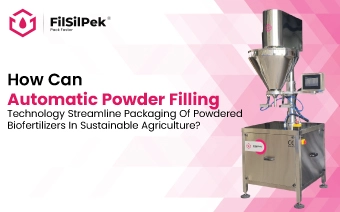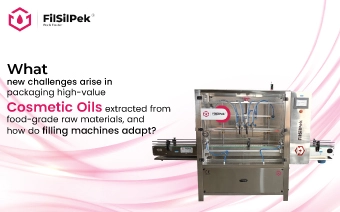How to Decide on the Right Packaging Machinery? – A Beginner Guide for Packaging Machine Buying
Choosing the correct packaging equipment can provide a company with numerous advantages. A well-chosen machine can boost output, save expenses, and decrease product rejection. Packaging machines can help organizations compete and open up new markets as a result of globalization and evolving technologies.
Naturally, adding any machine to a manufacturing line requires time and financial investment, so a company must think carefully about what it expects. If a machine isn’t consistent or doesn’t suit your current and future production processes, choosing the wrong selection can be costly.
In this guide, we’ll go over some key considerations for any company looking to buy a packaging machine. Understanding exactly what you require is critical when every money must be spent properly. It enables you to obtain an idea of what exactly you need for your product packaging line. Let’s dig in further.
Factors to consider while deciding on Packaging Machinery
Productivity
The productivity gains that your production line can realistically accomplish are one of the first concerns. You can buy a massive machine that can fill thousands of containers per hour, but if your conveyors, other machines, and staff are unable to handle the higher throughput, the greater efficiency is lost. Buying a slow machine, on the other hand, can create a bottleneck, especially if you need to ramp up production quickly.
Looking for machines that you can improve is a good idea. You could, for example, upgrade from semi-automatic to fully automatic or purchase more filling heads. Of course, you must also ensure that your other machinery, such as cappers and labeling systems, are capable of handling the workload. Naturally, an established packing machine manufacturer with experience in a variety of industries, such as the Filsilpek group, can provide realistic estimates.
Type of Filling
As you may expect, different items necessitate distinct characteristics in a packing machine. If you want to invest in a liquid filling machine, for example, thick creams and pastes may require a piston filler mechanism, although standard liquids can be filled by gravity. To avoid foaming, carbonated drinks require bottom-up filling heads, whereas bulk containers can be filled using a pump. A machine maker can provide you with the best recommendations if they understand your product’s qualities.
Filling Volume
The size of your containers will also influence which machine you need to buy. Filsilpek filling and packaging machines, for example, can fill containers as little as 10ml and as large as 5L, depending on the capacity of the machines.
Filling Precision
Filling precision is also a crucial factor. Overfilling can result in waste if volumes aren’t consistent, while underfilling puts your company in danger of losing consumers and regulators. Some manufacturers claim that their devices have a filling accuracy of +/-5 percent. Filsilpek’s machines fill to a tolerance of +/- 1 percent.
Adaptability
Finding versatile packing machinery is critical if you’re a business with a wide range of items. Machines that can handle a variety of container shapes and sizes are required, whereas capping machines may be required to accommodate a variety of sizes and configurations, such as pump heads and sports caps.
To boost efficiency, you could wish to add more filling heads or use a variety of cardboard packing boxes to pack your products. Your machine provider will once again advise you on how to ensure that your packaging machines meet all of your requirements.
Consistency
Any machine should be able to provide consistent quality regardless of the product or packing. Any productivity advantages are negated by misplaced labels, improperly sealed containers, or irregular product filling levels.
Friendly to Labor and Labor costs
The fundamental advantage of packaging machines is that they boost production while lowering labor costs and freeing up workers for other tasks. You must, however, factor in the time and money required to educate and employ operators. Low complexity and user-friendly controls are vital for most firms, as is a provider who provides assistance and training from the start.
Space And Workflow
A company should figure out how the machine will fit into its workflow during the conceptual stage. Businesses frequently ignore one aspect of packaging machinery: floor space. Make sure the machine physically fits, especially if you require extra equipment like hoppers, accumulation tables, or additional containers to scale up production. An experienced packing machine installation with Filsilpek Group can help you from the beginning, creating a system to fit your needs.
Cost Saving Techniques for Packaging Lines
1. Determine whether you want to use Manual or Automatic machinery
If your organization works with mass production and tight delivery dates on a regular basis, fully automatic packing lines will greatly improve performance and lower costs. Smaller orders and organizations that deal in highly customized orders can employ manual packing systems or semi-automatic lines.
2. Examine your packaging materials on a regular basis
An ideal packaging decision necessitates a thorough examination of the current material as well as the type of goods. By comparing the amount of material required vs the amount consumed, businesses can discover wastage. An industry expert’s audit may also discover regions of unusual waste. Administrators can adjust the material length as needed to make packing easier and faster.
3. Keep Track of Machine time
Examine the packing line for any slow places that are generating delays. Bottlenecks are the term for these points. Bottlenecks can be alleviated by lowering the level of input or increasing the packaging line’s efficiency. Firms can build appropriate machine schedules and take required remedial measures by evaluating the time loss caused by these bottlenecks.
4. Routine Inspections
Machines should be checked on a regular basis, if not on a more frequent basis, to ensure that they are in good operating order. Preventive maintenance refers to operations such as examining and replacing machine parts, lubricating equipment, and so on. Their main goal is to reduce the risk of failure that comes with breakdowns. If you don’t take these steps, your organization will end up spending more time and money on repairs rather than packaging. To avoid major problems, regular check-ups are usually suggested.
5. Skilled Labor
“The appropriate people are the firm’s most important asset,” as the saying goes. A trained and skilled crew is required for all packing lines, whether manual, automatic, or semi-automatic. Workers’ training is an important component in ensuring good packaging. The skilled labor staff will take care of the equipment and guarantee that it is used efficiently. The staff is better equipped to address problems that arise on the packing line as a result of technological knowledge and ability.
To-Do List for Effective Packaging
1. Do your homework
There are a few factors to keep in mind while developing the best packaging for your products:
A. The Product’s Nature and Contents
One of the most important factors in determining the sort of packaging to use is the nature of your product. Protecting the product is, of course, crucial. Milk and canned food, for example, are perishable and require a thick layer of packing. These items necessitate more effort and cost in terms of package protection. That doesn’t rule out the possibility of it becoming appealing. Even such packaging can be made appealing with current technology to attract more customers and secure repeat sales.
B. Who is the Product’s Target Audience?
Understanding your target audience’s preferences is crucial when making design decisions. It is more effective to use psychology when creating packaging. In comparison to a product developed for ladies or older citizens, a product designed for children should have a different color scheme.
C. Product Shelf-Life & Overall Durability
Examine the product thoroughly even after it has passed its expiration date (if any). The quality and type of material to be utilized will be determined by the product’s life cycle.
2. Making Use of Natural Resources and User-Friendly Materials
It is no longer an option to be ecologically responsible. If the human race is to survive, it must do so. People have begun to become ecologically sensitive on a global scale. Making packaging that is environmentally friendly has various advantages: it is not only good for the environment, but it also attracts attention and lowers package expenses.
Consumer-friendly packaging refers to packages that are simple to handle. The goal is straightforward: user convenience.
A “smart package” is a combination of environmentally responsible and user-friendly packaging that saves money while simultaneously standing out.
3. Repurposing Packaging Waste
Packaging scraps are frequently discarded. Instead of discarding these, they can be reused in packaging, such as for making additional elements of the package, such as the seal from the remaining package. Reusing this waste will necessitate a one-time investment in the proper packing technique, but the outcome will be ongoing cost savings.
4. Appropriate Packaging Methodology
The correct packaging solutions must be used depending on the type of product, the number of units to be created, floor space, and budgetary allocations. Depending on your product and organization, you can utilize automatic, semi-automatic, or manual packaging lines. If it contributes to packaging efficiency, a combination of all three can be used.
5. Establishing Control Parameters and Standards
Establishing and maintaining specified quality, waste, and material handling measures is a beneficial step toward cost reduction and ensuring a high-quality result. It is simple to define and administer such criteria in automatic devices. Workers for semi-automatic and manual systems, on the other hand, can be taught proper equipment handling. If any deviations from the stated measures are discovered, a correction plan must be implemented, as well as an investigation into what caused them.
Final Takeaways:
Packaging and Filling machines are productivity gainers for any business in today’s world, but the matter that matters the most is to decide on the right packaging machine that fits your business and organizational requirements, or else the misfit machine will pull your efficiency down instead of taking it to the next level. We at Filsilpek, listen to and understand all your requirements and caters to you with the best-fit packaging solution. To know more about the packaging solution that fits you, connect with us today at [email protected] and find the best packaging solution for your business.
How can automatic powder filling technology streamline packaging of powdered biofertilizers in sustainable agriculture?
The demand for biofertilizers has increased sharply as agriculture moves toward….
What new challenges arise in packaging high-value cosmetic oils extracted from food-grade raw materials, and how do filling machines adapt?
High-value cosmetic oils like argan, almond, jojoba, avocado….
How are D2C edible oil startups using smart filling systems to offer personalized packaging for home delivery?
Direct-to-consumer (D2C) edible oil brands are changing the way households buy and use cooking oils. By cutting….



